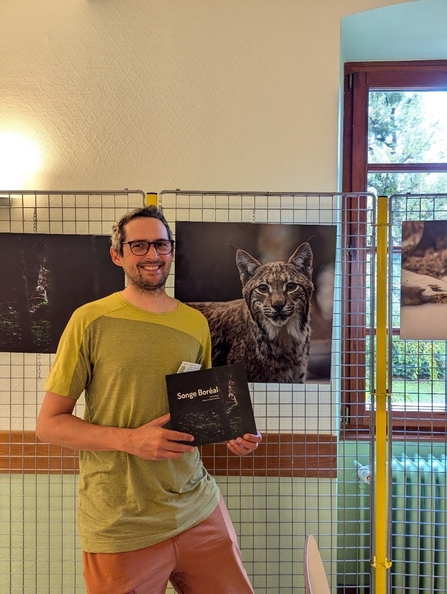At the start of October, members of The Missing Lynx Project team attended a three-day Eurolynx meeting in the foothills of the Northern Vosges National Park in France. Eurolynx is a scientific network that promotes collaborative science based on sharing knowledge and data to learn more about Eurasian lynx. This annual gathering of the academics and practitioners involved in Eurasian lynx research and conservation, as well as delegates from the Iberian lynx conservation initiative, is the best opportunity to hear about the latest findings from current lynx studies and reintroduction projects and to get to know the people involved.
Links across Europe
Attendees of the Eurolynx meeting

The Eurolynx team collates lynx data from all the conservation and research projects in Europe into one central database, giving researchers access to huge amounts of valuable data. As a result, the Eurolynx network publishes many high-quality scientific papers every year that help with our understanding of the lynx and the landscapes it inhabits throughout Europe.
Here are some of the highlights from each day of the conference:
Day 1
The Eurolynx meeting began with a presentation from the French team working on the Regional Action Plan for lynx in the Vosges massif. There is a small population of around 10 lynx in this area, which is linked to other lynx populations to the east (in the Palatinate Forest of Germany) and to the south (in the Southern Vosges, and the Swiss Jura).
The remainder of day one was packed to the brim with fascinating research talks, on topics as diverse as lynx foraging behaviour, predicting traffic collision risk, body size variation in the Lynx genus, and the best approach to camera trapping for lynx. The Missing Lynx Project’s team member Faye Whiley presented on her PhD research about public perceptions of lynx across Europe, which she is busy researching in parallel to her work on The Missing Lynx Project.

Faye presenting to the conference
Day 2
Day two opened with more fascinating presentations on research into things like the use of AI to identify individual lynx from the markings on their fur, and different strategies for tracking the movement of lynx using GPS collars. There were workshops to develop new areas of research and the afternoon saw a spectrum of presentations about current lynx reintroduction initiatives in Germany, Poland and our work here in the UK.
Our presentation focussed on The Missing Lynx Project’s work to assess the feasibility of reintroducing lynx to the UK – the key questions of whether lynx could survive here and how people feel about them. After our presentation we were asked lots of questions about the project. The most popular question was where we sourced the Missing Lynx Exhibition from! There were also talks by the Iberian lynx teams who have successfully rescued the species from its near-extinction in the early 2000s.

Team members Dr Deborah Brady and Dr Sam Cartwright co-presenting The Missing Lynx Project to the pan-European lynx delegation

The conference venue also exhibited the remarkable work of talented local photographer and wildlife biologist Antoine Rezer
Day 3
The final day of the meeting was a field visit to the Palatinate Forest (Pfälzerwald) in Germany, to hear from members of the team involved in the successful lynx reintroduction there during 2015-2021.

Team members from The Missing Lynx Project on a field visit to the Palatinate Forest
On our return to the Vosges we visited a ‘green bridge’ over a trunk road. This is a bridge constructed solely to allow wildlife to cross busy roads safely and reduce the risk of vehicle collisions. Such bridges are quite common in Europe but rare in the UK. The bridge has cameras that can detect and monitor the species using it, which include many small and medium sized mammals such as wildcat, wild boar, roe and red deer, fox, pine marten, hedgehog, badger, and of course, lynx.

A green bridge offering wildlife a safe route over a busy road
In total 109 delegates attended from countries across Europe, with more than 40 presentations during the three-day meet. The four team members representing The Missing Lynx Project absorbed masses of information during the full day programmes and discussed lynx matters with other delegates in the evenings.
Linking Lynx Expert Group
Three of the project team are also involved with the Linking Lynx Expert Group and they attended an additional afternoon discussion workshop, which was focussed on developing best practice protocols for lynx reintroductions. Usually these meetings are several times a year, but are held online given the international delegation, so it was nice to enjoy the enthusiastic discussion in person for a change!
Learning from Europe
This was not the first time The Missing Lynx Project team has attended the Eurolynx meetings. In previous years, when we were still in the early stages of planning what would become The Missing Lynx Project, we attended the annual Eurolynx meetings in Croatia, Germany and online (during the Covid pandemic). The result is we now know many of the European lynx researchers and project teams well, and their expertise and advice from the earliest stages of The Missing Lynx Project have been invaluable. Some of these experts also sit on the project’s steering group.

